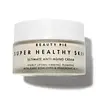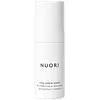What's inside
What's inside
 Key Ingredients
Key Ingredients

 Benefits
Benefits

 Concerns
Concerns

 Ingredients Side-by-side
Ingredients Side-by-side

Water
Skin ConditioningCaprylic/Capric Triglyceride
MaskingGlycerin
HumectantCoco-Caprylate/Caprate
EmollientButylene Glycol
HumectantEthylhexyl Palmitate
EmollientArachidyl Alcohol
EmollientGlyceryl Stearate
EmollientPEG-100 Stearate
Dimethicone
EmollientBehenyl Alcohol
EmollientPhenoxyethanol
PreservativeCarbomer
Emulsion StabilisingPropanediol
SolventOryza Sativa Hull Powder
AbrasiveArachidyl Glucoside
EmulsifyingTocopheryl Acetate
AntioxidantChlorphenesin
AntimicrobialMica
Cosmetic ColorantCI 77891
Cosmetic ColorantAvena Sativa Kernel Extract
AbrasiveSodium Hydroxide
BufferingVp/Va Copolymer
Hydrolyzed Hyaluronic Acid
HumectantSodium Hyaluronate
HumectantParfum
MaskingO-Cymen-5-Ol
AntimicrobialAsparagus Officinalis Stem Extract
Skin ConditioningTetrasodium Glutamate Diacetate
Isomalt
HumectantLeontopodium Alpinum Flower/Leaf Extract
Skin ConditioningAlgae Extract
EmollientSodium Benzoate
MaskingHydrolyzed Beta-Glucan
Skin ConditioningAlteromonas Ferment Extract
Skin ConditioningPhenethyl Alcohol
MaskingPotassium Sorbate
PreservativeLimonene
PerfumingBuddleja Davidii Leaf Extract
Skin ConditioningThymus Vulgaris Flower/Leaf Extract
MaskingDiacetyl Boldine
Skin ConditioningCalcium Gluconate
HumectantGluconolactone
Skin ConditioningRhododendron Ferrugineum Extract
MaskingNarcissus Tazetta Bulb Extract
AstringentCitric Acid
BufferingLinalool
PerfumingLecithin
EmollientVitis Vinifera Fruit Cell Extract
Skin ConditioningDisodium Phosphate
BufferingWater, Caprylic/Capric Triglyceride, Glycerin, Coco-Caprylate/Caprate, Butylene Glycol, Ethylhexyl Palmitate, Arachidyl Alcohol, Glyceryl Stearate, PEG-100 Stearate, Dimethicone, Behenyl Alcohol, Phenoxyethanol, Carbomer, Propanediol, Oryza Sativa Hull Powder, Arachidyl Glucoside, Tocopheryl Acetate, Chlorphenesin, Mica, CI 77891, Avena Sativa Kernel Extract, Sodium Hydroxide, Vp/Va Copolymer, Hydrolyzed Hyaluronic Acid, Sodium Hyaluronate, Parfum, O-Cymen-5-Ol, Asparagus Officinalis Stem Extract, Tetrasodium Glutamate Diacetate, Isomalt, Leontopodium Alpinum Flower/Leaf Extract, Algae Extract, Sodium Benzoate, Hydrolyzed Beta-Glucan, Alteromonas Ferment Extract, Phenethyl Alcohol, Potassium Sorbate, Limonene, Buddleja Davidii Leaf Extract, Thymus Vulgaris Flower/Leaf Extract, Diacetyl Boldine, Calcium Gluconate, Gluconolactone, Rhododendron Ferrugineum Extract, Narcissus Tazetta Bulb Extract, Citric Acid, Linalool, Lecithin, Vitis Vinifera Fruit Cell Extract, Disodium Phosphate
Water
Skin ConditioningPentylene Glycol
Skin ConditioningCoco-Caprylate/Caprate
EmollientPrunus Amygdalus Dulcis Oil
Skin ConditioningSqualane
EmollientGlyceryl Stearate Citrate
EmollientRosa Canina Fruit Oil
EmollientCetearyl Alcohol
EmollientBiosaccharide Gum-1
HumectantSodium Hyaluronate
HumectantAloe Barbadensis Leaf Juice
Skin ConditioningSodium Levulinate
Skin ConditioningChamomilla Recutita Flower Extract
MaskingSodium Ascorbyl Phosphate
AntioxidantDipotassium Glycyrrhizate
HumectantGlyceryl Caprylate
EmollientSaccharide Isomerate
HumectantGlycerin
HumectantTocopheryl Acetate
AntioxidantTocopherol
AntioxidantSclerotium Gum
Emulsion StabilisingXanthan Gum
EmulsifyingSodium Citrate
BufferingMaltodextrin
AbsorbentSodium Anisate
AntimicrobialSodium Gluconate
Skin ConditioningCitric Acid
BufferingWater, Pentylene Glycol, Coco-Caprylate/Caprate, Prunus Amygdalus Dulcis Oil, Squalane, Glyceryl Stearate Citrate, Rosa Canina Fruit Oil, Cetearyl Alcohol, Biosaccharide Gum-1, Sodium Hyaluronate, Aloe Barbadensis Leaf Juice, Sodium Levulinate, Chamomilla Recutita Flower Extract, Sodium Ascorbyl Phosphate, Dipotassium Glycyrrhizate, Glyceryl Caprylate, Saccharide Isomerate, Glycerin, Tocopheryl Acetate, Tocopherol, Sclerotium Gum, Xanthan Gum, Sodium Citrate, Maltodextrin, Sodium Anisate, Sodium Gluconate, Citric Acid
Ingredients Explained
These ingredients are found in both products.
Ingredients higher up in an ingredient list are typically present in a larger amount.
Citric Acid is an alpha hydroxy acid (AHA) naturally found in citrus fruits like oranges, lemons, and limes.
Like other AHAs, citric acid can exfoliate skin by breaking down the bonds that hold dead skin cells together. This helps reveal smoother and brighter skin underneath.
However, this exfoliating effect only happens at high concentrations (20%) which can be hard to find in cosmetic products.
Due to this, citric acid is usually included in small amounts as a pH adjuster. This helps keep products slightly more acidic and compatible with skin's natural pH.
In skincare formulas, citric acid can:
While it can provide some skin benefits, research shows lactic acid and glycolic acid are generally more effective and less irritating exfoliants.
Most citric acid used in skincare today is made by fermenting sugars (usually from molasses). This synthetic version is identical to the natural citrus form but easier to stabilize and use in formulations.
Read more about some other popular AHA's here:
Learn more about Citric AcidCoco-Caprylate/Caprate is created from fatty coconut alcohol, caprylic acid, and capric acid.
It is a lightweight emollient. Emollients create a thin barrier on the skin to trap moisture in. This helps keep your skin hydrated and soft.
Once applied, Coco-Caprylate/Caprate is absorbed quickly and leaves a silky feel.
Coco-Caprylate/Caprate may not be fungal acne safe.
Learn more about Coco-Caprylate/CaprateGlycerin is already naturally found in your skin. It helps moisturize and protect your skin.
A study from 2016 found glycerin to be more effective as a humectant than AHAs and hyaluronic acid.
As a humectant, it helps the skin stay hydrated by pulling moisture to your skin. The low molecular weight of glycerin allows it to pull moisture into the deeper layers of your skin.
Hydrated skin improves your skin barrier; Your skin barrier helps protect against irritants and bacteria.
Glycerin has also been found to have antimicrobial and antiviral properties. Due to these properties, glycerin is often used in wound and burn treatments.
In cosmetics, glycerin is usually derived from plants such as soybean or palm. However, it can also be sourced from animals, such as tallow or animal fat.
This ingredient is organic, colorless, odorless, and non-toxic.
Glycerin is the name for this ingredient in American English. British English uses Glycerol/Glycerine.
Learn more about GlycerinSodium Hyaluronate is hyaluronic acid's salt form. It is commonly derived from the sodium salt of hyaluronic acid.
Like hyaluronic acid, it is great at holding water and acts as a humectant. This makes it a great skin hydrating ingredient.
Sodium Hyaluronate is naturally occurring in our bodies and is mostly found in eye fluid and joints.
These are some other common types of Hyaluronic Acid:
Learn more about Sodium HyaluronateTocopheryl Acetate is AKA Vitamin E. It is an antioxidant and protects your skin from free radicals. Free radicals damage the skin by breaking down collagen.
One study found using Tocopheryl Acetate with Vitamin C decreased the number of sunburned cells.
Tocopheryl Acetate is commonly found in both skincare and dietary supplements.
Learn more about Tocopheryl AcetateWater. It's the most common cosmetic ingredient of all. You'll usually see it at the top of ingredient lists, meaning that it makes up the largest part of the product.
So why is it so popular? Water most often acts as a solvent - this means that it helps dissolve other ingredients into the formulation.
You'll also recognize water as that liquid we all need to stay alive. If you see this, drink a glass of water. Stay hydrated!
Learn more about Water